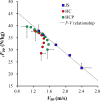Portions of the force-velocity relationship targeted by weightlifting exercises
- PMID: 39730831
- PMCID: PMC11681094
- DOI: 10.1038/s41598-024-82251-8
Portions of the force-velocity relationship targeted by weightlifting exercises
Abstract
We compared the force-velocity (F-V) characteristics between jump squat (JS) and weightlifting (hang clean [HC] and HC pull [HCP]) to determine lower limb F-V portions targeted by weightlifting exercises. Ten weightlifters performed JS at 0% (body weight only) to 70% of their one-repetition maximum (1RM) for back squat, and HC and HCP at 30‒90% and 30‒110% of their 1RM for HC, respectively. Force and velocity values at each relative load were plotted to determine the F-V features of JS, HC, and HCP. Linear regression was used to evaluate each participant's JS F-V results to obtain individual F-V relationships. Regression equations evaluated the JS force at a given velocity for each relative load of HC and HCP. HC produced significantly less force than JS at given velocities for 30%, 40%, and 50% 1RM. Furthermore, HCP produced significantly less force than JS at a given velocity for 30% 1RM and exhibited less force than JS at a given velocity for 40% 1RM with moderate effect size. HC and HCP produce comparable forces to JS within the velocity ranges of 60‒90% and 50‒110% 1RM, respectively. Thus, weightlifting exercises target low‒moderate-velocity portion of the lower limb F-V relationship.
Keywords: Force–velocity characteristics; Hang clean; Hang clean pull; Jump squat; Power training; Weightlifting.
© 2024. The Author(s).
Conflict of interest statement
Declarations. Competing interests: The authors declare no competing interests.
Figures







Similar articles
-
Kinetic comparison of the power development between power clean variations.J Strength Cond Res. 2014 Feb;28(2):350-60. doi: 10.1519/JSC.0b013e31829a36a3. J Strength Cond Res. 2014. PMID: 23689341
-
Velocity-Based Training With Weightlifting Derivatives: Barbell and System Velocity Comparisons.J Strength Cond Res. 2025 Feb 1;39(2):135-146. doi: 10.1519/JSC.0000000000004962. Epub 2024 Oct 24. J Strength Cond Res. 2025. PMID: 39446798 Clinical Trial.
-
Where does the One-Repetition Maximum Exist on the Force-Velocity Relationship in Squat?Int J Sports Med. 2017 Nov;38(13):1035-1043. doi: 10.1055/s-0043-116670. Epub 2017 Oct 1. Int J Sports Med. 2017. PMID: 28965339
-
Unique aspects of competitive weightlifting: performance, training and physiology.Sports Med. 2012 Sep 1;42(9):769-90. doi: 10.1007/BF03262294. Sports Med. 2012. PMID: 22873835 Review.
-
Weightlifting pulling derivatives: rationale for implementation and application.Sports Med. 2015 Jun;45(6):823-39. doi: 10.1007/s40279-015-0314-y. Sports Med. 2015. PMID: 25689955 Review.
References
-
- Hicks, D. S., Schuster, J. G., Samozino, P. & Morin, J. B. Improving mechanical effectiveness during sprint acceleration: practical recommendations and guidelines. Strength Cond. J.42, 45–62 (2020).
-
- Morin, J. B., Samozino, P., Bonnefoy, R., Edouard, P. & Belli, A. Direct measurement of power during one single sprint on treadmill. J. Biomech.43, 1970–1975 (2010). - PubMed
-
- Cormie, P., McGuigan, M. R. & Newton, R. U. Influence of strength on magnitude and mechanisms of adaptation to power training. Med. Sci. Sports Exerc.42, 1566–1581 (2010). - PubMed
-
- Kawamori, N. & Newton, R. U. Velocity specificity of resistance training: actual movement velocity versus intention to move explosively. Strength Cond. J.28, 86 (2006).
-
- Cormie, P., McGuigan, M. R. & Newton, R. U. Developing maximal neuromuscular power: part 2-training considerations for improving maximal power production. Sports Med.41, 125–146 (2011). - PubMed
MeSH terms
Grants and funding
LinkOut - more resources
Full Text Sources
Miscellaneous

